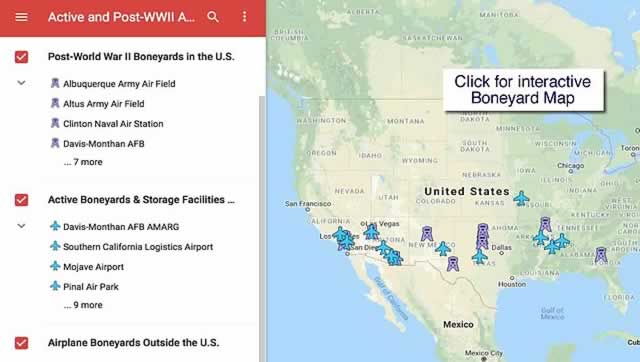
Long-Term Military Aircraft Storage Facilities After World War II
Military aircraft played a key role in the United States's victory over enemy forces in World War II.
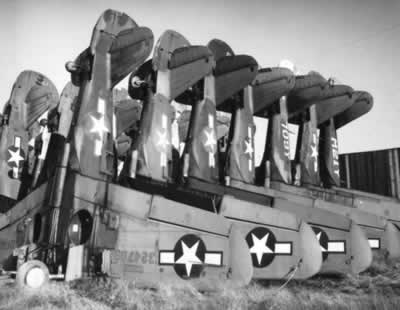 Curtiss P-40 Warhawk fighters stacked vertically at Walnut Ridge, Arkansas after World War II (Photo courtesy of Walnut Ridge Army Flying School Museum) |
However, once peace was assured, the military found itself with a huge surplus of aircraft. The United States had manufactured about 294,000 aircraft for the war effort. Of that number, 21,583 (7.34%) were lost in the United States in test flights, ferrying, training accidents, etc., and 43,581 were lost en route to the war and in overseas operations.
By 1944 the U.S. Foreign Economic Administration began a program to scrap certain obsolete, damaged and surplus military aircraft overseas. Following the war, estimates of the number of excess surplus airplanes ran as high as 150,000. Consideration was given to storing a substantial number of airplanes, but the realization that the expense to store them was too great ... many needed to be sold or scrapped.
Some U.S. military aircraft overseas were not worth the time or money to bring back to the States, and were consequently buried, bulldozed or sunk at sea. Most, however, were returned home for storage, sale or scrapping.
What to Do with Tens of Thousands of Surplus Aircraft: Salvage or Long-Term Storage
Within a year of the signing of peace treaties, about 34,000 airplanes had been moved to 30 locations within the U.S. The War Assets Administration (WAA) and the Reconstruction Finance Corporation (RFC) handled the disposal of these aircraft.
The RFC established depots around the country to store and sell surplus aircraft. By the summer of 1945, at least 30 sales-storage depots and 23 sales centers were in operation. In November 1945, it was estimated a total of 117,210 aircraft would be transferred as surplus.
A study was conducted to determine the most cost effective way to dispose of planes; it was determined that too many man-hours were required to dismantle planes for parts, and the cost for storage areas for the parts was too high.
So the method of "salvage and melt" was adopted. Main components such as engines, armament, instruments and radios were removed from each plane. The remainder of the aircraft was cut into pieces, and pushed in a large furnace, or smelter. Aluminum was the prime metal sought after, melted and poured into ingots for sale and shipping.
Airlines procured a number of transport planes, primarily DC-3 and C-54 aircraft, for building up their post-war inventories of commercial airliners.
Others planes were transferred to civilian control, or to the Air Forces of allied countries. A few, such as the "Enola Gay" and "Bockscar" (see photo below), would be preserved for display in museums.
The remaining planes were classified as 1) "obsolete" or 2) "eligible for the strategic aircraft reserve". The jet revolution made many aircraft obsolete, including the P-38, B-17 and B-24, among others, while planes like the B-29, A-26 Invader, and C-47 were destined for the reserve.
Planes were then assigned an airport, at places like Kingman and Walnut Ridge for short-term storage and subsequent disposal, or Davis-Monthan or Pyote for longer-term storage.
Long-Term Storage of World War II Aircraft for Future Usage
In early 1945 the Air Technical Service Command (ATSC) began to research locations suitable for storage of excess military aircraft. Air field near coastlines subjected aircraft to mold, corrosion and rust. Locations in the north were subject to snow storms and other inclement weather. Eventually, workable storage locations were identified.
Most obsolete planes were transferred to one of 28 storage locations, including these eight large disposal facilities:
- Kingman AAF in Arizona
- Walnut Ridge AAF in Arkansas
- Ontario Cal-Aero Field in California
- Altus in Oklahoma
- Albuquerque in New Mexico
- Clinton Naval Air Station, Oklahoma
- Searcy Field in Stillwater, Oklahoma
- Victory Field in Vernon, Texas
... about boneyard facilities for scrapping and melting surplus WWII aircraft
Longer-Term Military Aircraft Reserve Storage Facilities
By 1947 the WAA had disposed of about 65,000 aircraft. However, some aircraft would be stored in reserve and retained for future return to active duty.
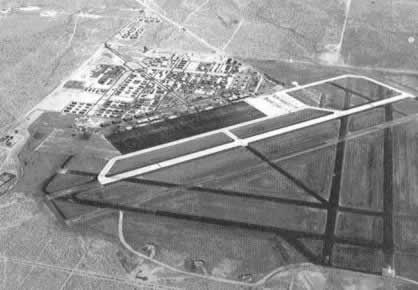 Victorville Army Air Field, August, 1943 |
Planes were stored at several locations across the country, including Victorville in California, Pyote in Texas, Warner Robins in Georgia, and Davis-Monthan in Arizona.
Victorville AAF in California
Victorville Army Flying School was constructed between 1941 and 1943 as a flight training school, located 8 miles northwest of Victorville, California, and about 75 miles northeast of Los Angeles.
It was renamed Victorville Army Air Field in April of 1943. After the creation of the United States Air Force, it was renamed Victorville Air Force Base in January of 1948, and later to George Air Force Base in 1950 in honor of Brigadier General Harold Huston George.
In October of 1945, flight operations ended, and the base was placed on standby status and used for surplus aircraft storage, primarily B-29 Superfortresses, AT-7s and AT-11s.
George AFB was closed by the Base Realignment and Closure (BRAC) 1992 commission, and now is a successful and active facility for business and industry, known as the Southern California Logistics Airport.
Pyote Army Air Field in Texas
This field was located west of Midland, Texas, east of Pecos, and north of Fort Stockton, along present-day Interstate 20. It was built for bombardment crew training in 1942, and named Pyote Army Air Field.
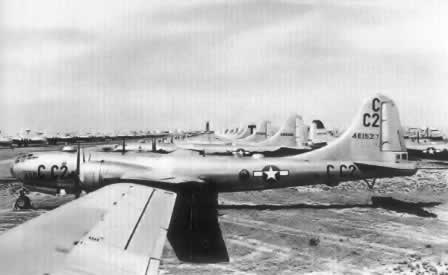 B-29 Superfortresses in storage at Pyote Air Force Base, Texas, 1946 |
After the war, control of Pyote Air Force Base was transferred from the Second Air Force to the San Antonio Air Tech Service Command and became an aircraft-storage depot. During this time, the base served as a storage facility for as many as 2,000 aircraft (B-29, B-17, B-25, A-26, C-47, and others), including the "Enola Gay". Due to the large number of snakes at the site, it was often called "Rattlesnake Bomber Base".
During the 1950s the base was abandoned. The remaining large hangars gradually disappeared over the years. Today only runways and a few ruins mark the location of the base.
Warner Robins Army Air Depot in Georgia
In June 1941, after much competition, the War Department approved the construction of a depot in middle Georgia peanut-farm country near the Southern Railroad whistle-stop town of Wellston.
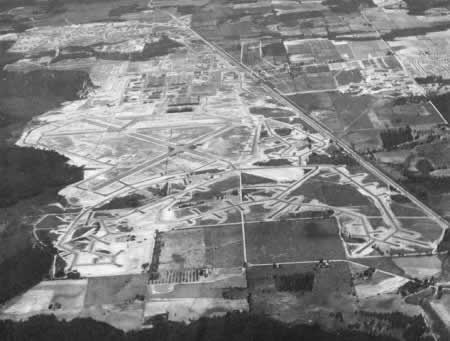 Warner Robins Army Air Depot, 1944 |
Construction began in September 1941 on the new depot 15 miles south of Macon, Georgia.
In January 1942, it was named "Robins Field" in memory of Brigadier General Augustine Warner Robins. In October 1942, the depot's name was changed again, "Warner Robins Army Air Depot."
The rapidly growing town of Wellston changed its name to Warner Robins in September of 1942.
Warner Robins Army Air Depot eventually assumed overall command of the Air Service Command's installations in the states of Georgia, South Carolina, a portion of Florida, and North Carolina. Warner Robins supported approximately 6,500 Army aircraft in this area with depot maintenance and supply.
The depot's complement began a steady decline after the war, and by March of 1946 only 3,900 employees remained. In the post-war era, the depot assumed the task of storing surplus war material and thousands of vehicles. The depot also cocooned and stored 250 B-29s. In February of 1948, the airfield was re-designated Robins Air Force Base.
In addition to its normal mission, the depot returned most of the stored B-29s to active service during the Korean War. During the war, Robins AFB overhauled and modified B-29 and F-84 aircraft as well as repairing F-80 and F-86 fighters. In 1951, the Air Force began a $3.5 million construction project. When this project reached completion in 1952, the Air Force made Robins AFB a permanent installation.
Today, Robins AFB remains an active base.
Litchfield Park / Phoenix Goodyear Airport (GYR)
This facility in Phoenix, Arizona was originally constructed during World War II as a naval air facility known as NAF Litchfield Park, and later renamed Naval Air Station Litchfield Park.
In 1941, the Goodyear Aerospace Corporation offered land to the U.S. Defense Plant Corporation. The U.S. Navy used the land to build aircraft flight decks and established a U.S. Naval Air Facility to test fly and deliver aircraft. This necessitated the construction of a landing field, hangar and runway. The Goodyear facility was used to modify AAF twin-tail B-24 Liberators for use as Navy PB4Y-1 aircraft, and to accept delivery of Navy single-tail PB4Y-2 Privateers.
Its primary role following the end of World War II was that of long-term storage and preservation of obsolete or excess U.S. Navy, U.S. Marine Corps and U.S. Coast Guard aircraft. Its location in the dry desert was an ideal location for long-term aircraft storage.
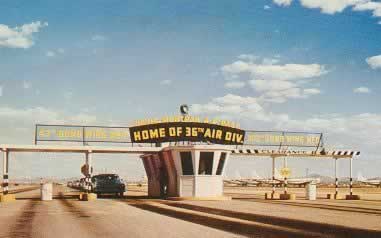 Entrance gate to Davis-Monthan Air Force Base, Home of the 36th Air Division, as seen in this historic postcard |
At one point, more than 5,000 aircraft were in storage. The Korean Conflict brought the airfield back to active duty in the 1950s. By early 1958 the inventory was down to about 2,500 aircraft. In 1965, the Defense Department decided to consolidate military aricraft storage. Thus, 800 aircraft at Litchfield were moved to Davis-Monthan Air Force Base in Tucson either by air or by truck for storage, and another 1,000 were salvaged.
Following the closure of NAS Litchfield Park in 1967, the city of Phoenix purchased the airport for a general aviation facility. Today, the airport is home to several private companies offering aircraft maintenance and commercial pilot training, and serves as a reliever airfield for Phoenix Sky Harbor.
Davis-Monthan Air Force Base
By May of 1946, more than 600 B-29 Superfortresses and 200 C-47 Skytrains had been moved to Davis-Monthan. In addition, about 30 other aircraft were stored that were destined for museums, including the "Enola Gay" and "Bockscar".
Over the long-term, Davis-Monthan would become the only permanent storage and disposal facility for all branches of the U.S. military.
... about Davis-Monthan AFB and view photos of the AMARG boneyard
 |
|||
 |
 |
 |
 |
Photographs of Post-World War II Aircraft Boneyards and Scrapping Facilities
Aerial view of Davis-Monthan Air Force Base, May 1946,
showing more than 600 B-29 Superfortress and 200 C-47 aircraft |
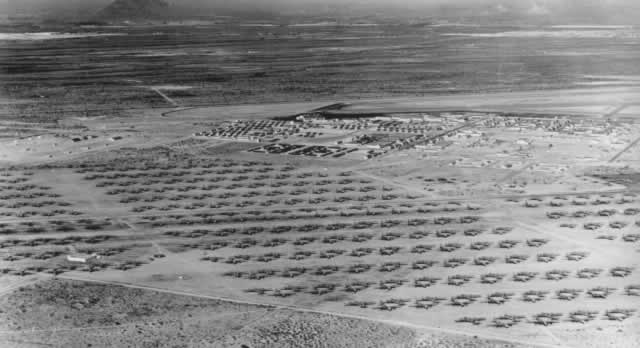 |
Aerial view of surplus military aircraft in storage at the Kingman aircraft boneyard in 1946 |
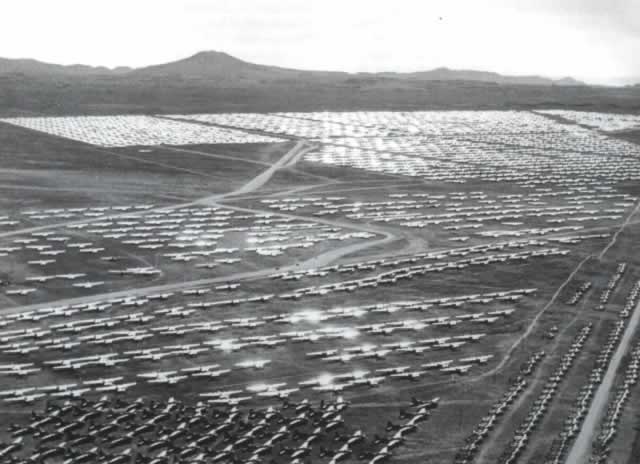 |
Aerial view of Walnut Ridge, Arkansas, in November, 1945 (Walnut Ridge Army Flying School Museum) |
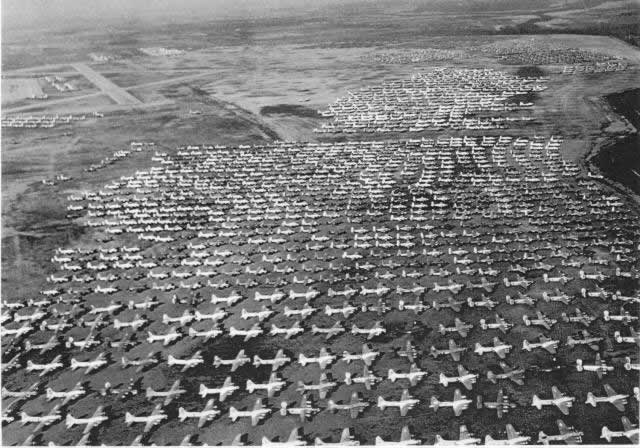 |
B-32 Dominator bombers stored at Walnut Ridge, Arkansas, after World War II (Walnut Ridge Army Flying School Museum) |
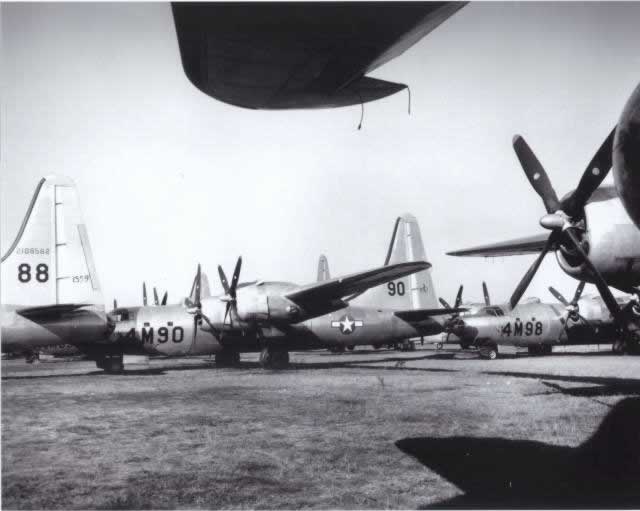 |
B-29 Superfortress bombers in storage at Pyote Air Force Base, Texas, circa 1946 |
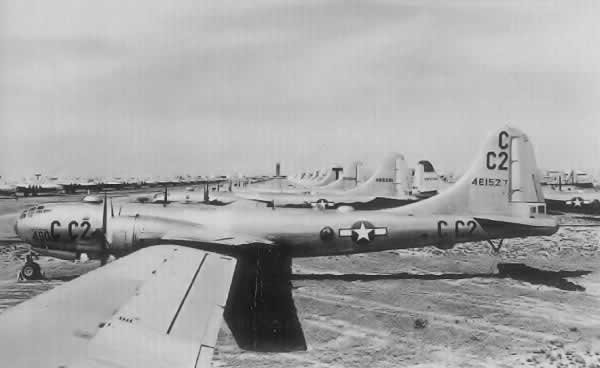 |
Boeing B-29 Superfortress "Enola Gay" ... in storage at Pyote AFB after World War II |
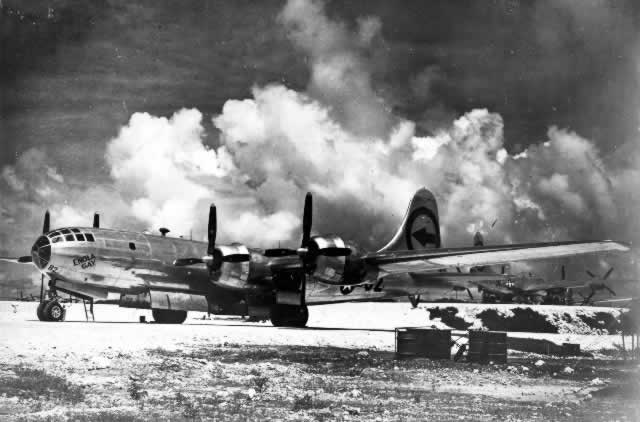 |
Boeing B-29 "Bockscar" in storage at Davis-Monthan AFB Now restored and on display at the Museum of the United States Air Force in Dayton, Ohio |
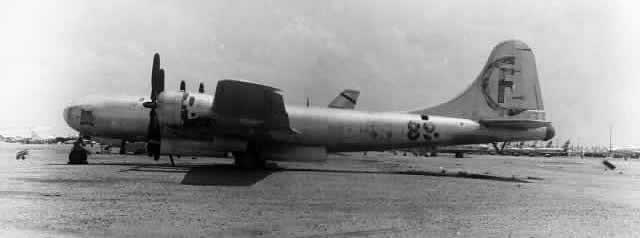 |
B-29 Superfortress cocooning at Warner Robins Air Material Area in Georgia, July, 1946 |
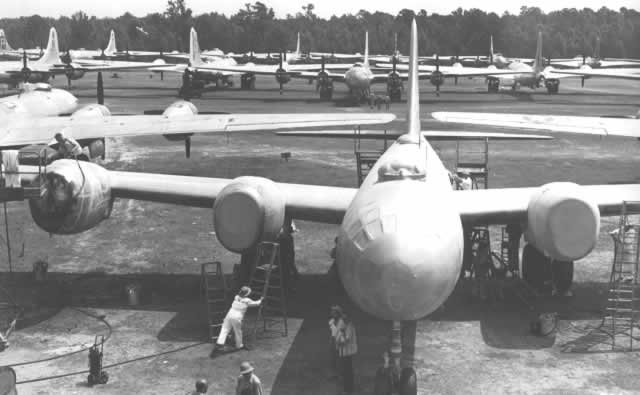 |
Aerial view of surplus military aircraft in storage at Cal-Aero Field, California after WWII (Photo used by permission of the photographer, William T. Larkins) |
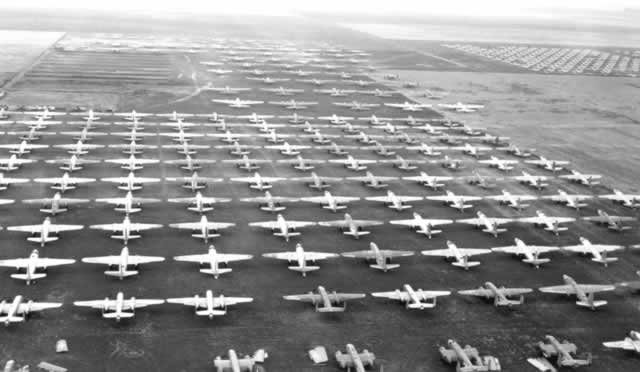 |
Bomber Scrapping and Smelting Process at the Kingman Army Air Field boneyard in Arizona
Rows of B-24 Liberators await the scrap heap at Kingman AAF in Arizona "Old Black Magic" 0333 in the foreground as seen in LIFE Magazine |
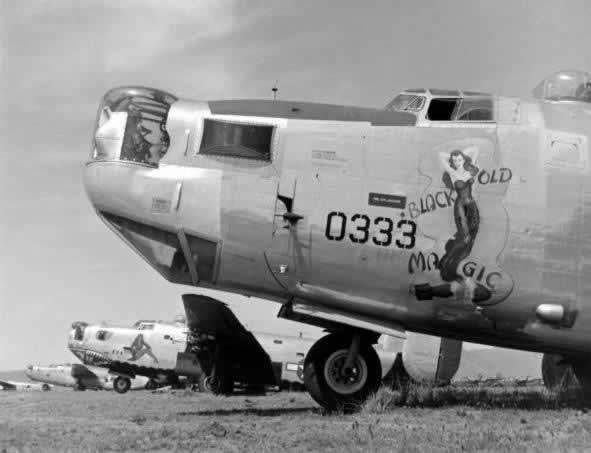 |
B-24 Liberator "Mabel's Labels" ... "Gimme a Great Big Smile!" engines removed and awaiting the guillotine and smelter |
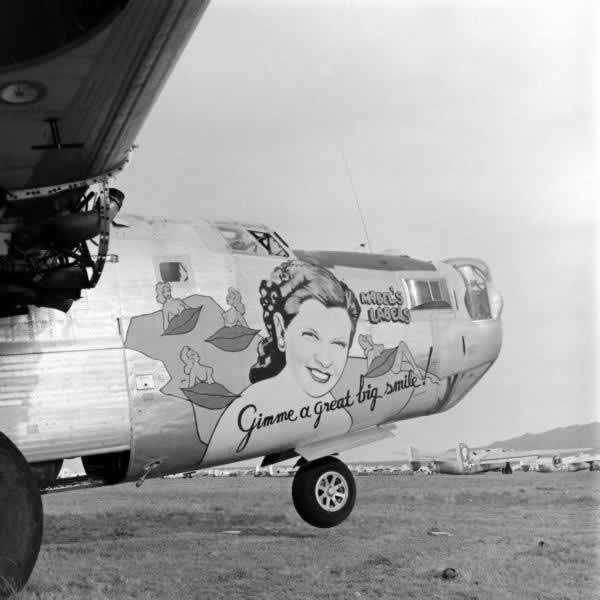 |
Rows of aircraft engines removed from surplus bombers at the Kingman boneyard |
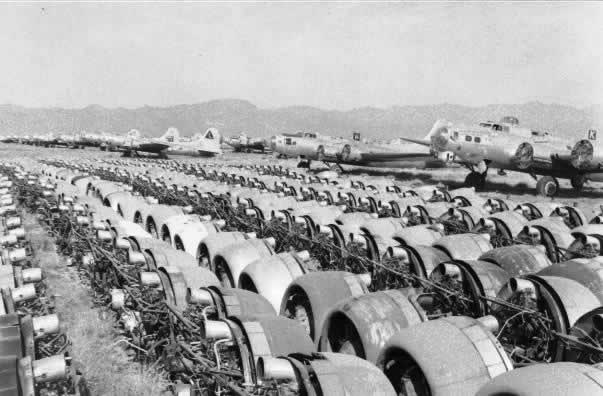 |
B-24 Liberator "Missouri Miss" meets the guillotine at Kingman Army Air Field |
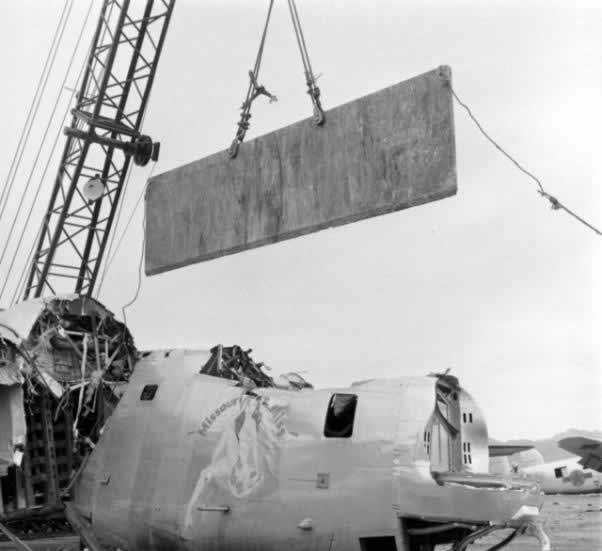 |
Once cut in pieces, aircraft remnants are moved to the smelter (in the distance) |
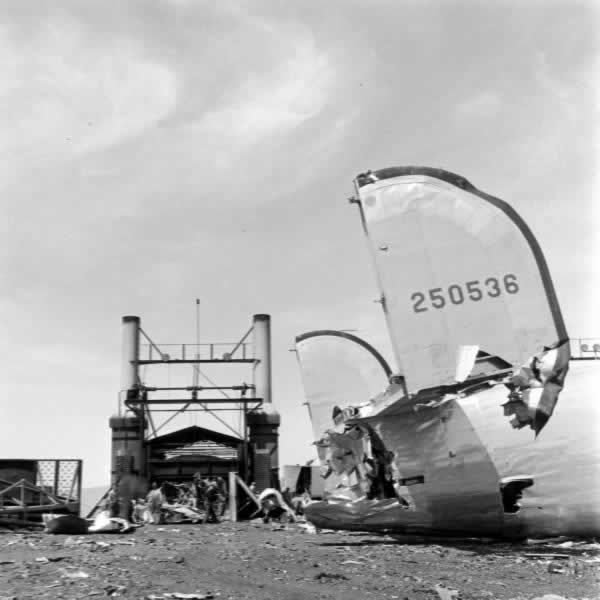 |
One of the three smelters, or furnaces, used at Kingman to melt aircraft parts |
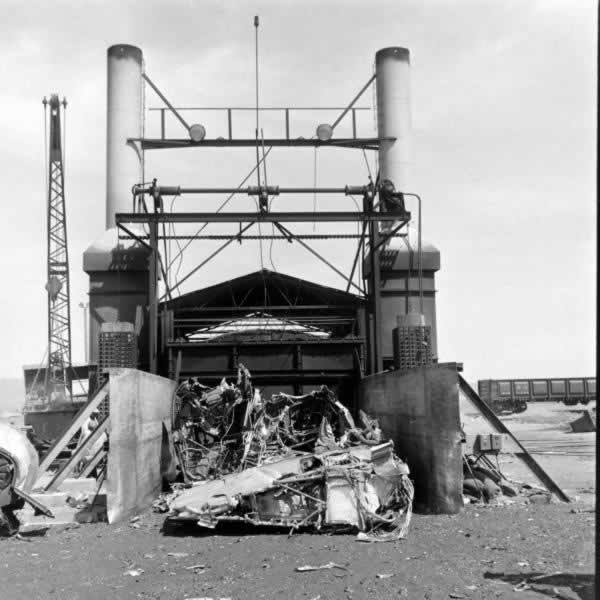 |
Stacks of aluminum ingots ... the remains of the great American World War II bomber fleet |
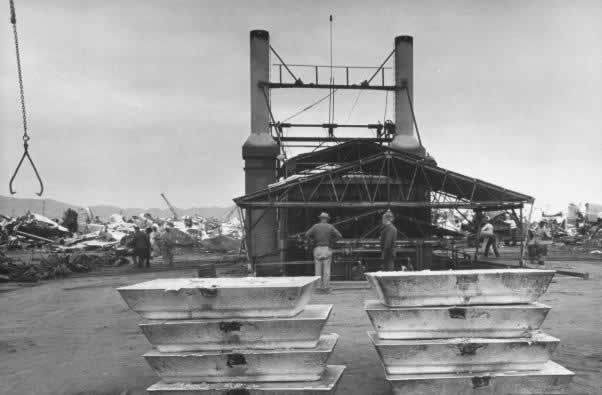 |
Map of locations of active and post-WWII airplane boneyards and plane storage facilities in the United States
